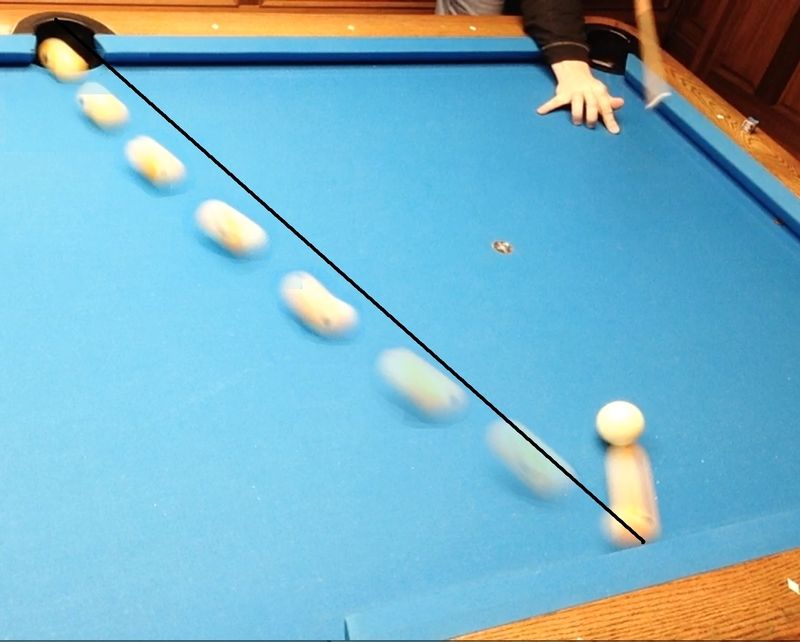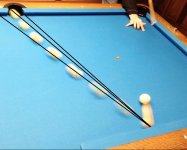You are using an out of date browser. It may not display this or other websites correctly.
You should upgrade or use an alternative browser.
You should upgrade or use an alternative browser.
Bank shots...
- Thread starter John Brumback
- Start date
I, on the other other hand, have already been at the pool hall for a couple hours - like every day.I on the other hand am actually gonna go out to the pool room, and attempt to put my sorry excuse of a stroke, in action.
Maybe I'll figure out what a real stroke is one of these years...
pj
chgo
This shot is not difficult at all, and it certainly doesn't require any type of "special sauce" (although, you do need to know how much speed, cut angle, and/or spin to use make it work). It also does not involve post-rebound OB-path curving. It simple uses cut-induced-spin or spin-induced-spin on the OB to change the rebound direction off the rail.
Regards,
Dave
If you are referring to the shot in my picture, then that is entirely untrue. There is no way you can make a cross-side bank that is lined up from the corner pocket directly through the diamond below the side pocket with center ball and speed only.
I'm not talking about cutting the bank... at all... I'm talking about shooting it directly through the diamond below the side pocket, full ball, and holding it to make the shot.
Yeah, you may be able to bend the object ball rebounding off of the rail, but I can make the object ball go in a complete circle using my patented CTE, triple pivot, fly on the wall technique while utilizing a laminated zero deflection zebra wood shaft with a tip made out of salt cured red marmoset foreskin. You would be amazed. I'll put up a video for sale soon.
..other hand, have already been at the pool hall for a couple hours - like every day.
pj
chgo
Yet you still can't bend a ball.
:smilewinkgrin:
That line is placed on the center of the ball on the rail and then off to the side of the ball in the pocket making it look like more of a curve than it actually is.
That line is placed on the center of the ball on the rail and then off to the side of the ball in the pocket making it look like more of a curve than it actually is.
The line is going directly into the center of the pocket from the point where the OB contacted the rail. If the OB followed that line it would hit the lower point on the side pocket and would not go in.
Oh yeah, I forgot... only stupid people can really play. Thanks for reminding me of our respective places in the pool hierarchy.Yet you still can't bend a ball.
pj
chgo
P.S. I've argued in this thread that bending the ball is possible - even automatic for some hits.
The line is going directly into the center of the pocket from the point where the OB contacted the rail. If the OB followed that line it would hit the lower point on the side pocket and would not go in.
Why did you draw the line to the center of the pocket?
Why did you draw the line to the center of the pocket?
Because that is the most logical place to put it to illustrate the bend.
Now I put a line through the original path the OB was on before it started bending. Keep in mind the natural angle would take the OB even higher than the line I just drew. If this doesn't convince anyone I guess I'm just bad at demonstrating it.

Because that is the most logical place to put it to illustrate the bend.
Now I put a line through the original path the OB was on before it started bending. Keep in mind the natural angle would take the OB even higher than the line I just drew. If this doesn't convince anyone I guess I'm just bad at demonstrating it.

Just draw the line from where the ball is on the rail and where the ball is in the pocket. There is a little curve but not near as much as your illustration makes it appear imo.
Exactly. See how much the ball is away from the line in the middle of the line (or wherever the max deviation from the straight line is).Just draw the line from where the ball is on the rail and where the ball is in the pocket. ..
The line is going directly into the center of the pocket from the point where the OB contacted the rail. If the OB followed that line it would hit the lower point on the side pocket and would not go in.
Same thing my wife and son said when they saw my shot!! .haha JB
Looks to me like you guys are hitting hard enough that the object ball comes off the rail in the air (in a straight line) then the spin causes it to curve back when it regains traction on the cloth. In the video some have posted you can see the ball bounce about a foot off the rail.
That first line is to the middle of the BACK of the pocket, not the pocket opening.
Because that is the most logical place to put it to illustrate the bend.
Now I put a line through the original path the OB was on before it started bending. Keep in mind the natural angle would take the OB even higher than the line I just drew. If this doesn't convince anyone I guess I'm just bad at demonstrating it.

Jamie ol buddy,if they can't see that ball curving there is no help we can give. As I like to say...some people are just too smart to learn. Lets just drop it and give in to the know it alls

